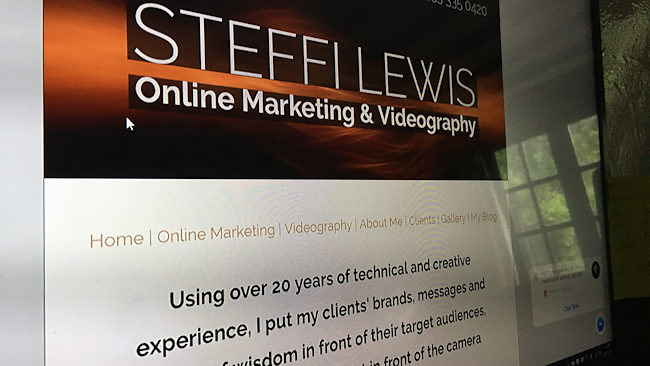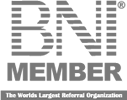An expert in a lot of online stuff …
Online marketing is not an area I’m overly familiar with. Yes, I use Facebook and can share stuff and comment, but when it comes to getting my brand out there, I’d rather delegate it to a trusted partner …

My trusted partner, Steffi Lewis is the business blogging expert!
copyright: steffi lewis online marketing & videography
Experts are there to assist you with all aspects of your business. Don’t want to do something? Can’t do something? Haven’t got the time to learn how? Working with an expert (in my case I call them my ‘trusted partners’) means you can delegate any aspect of your business that isn’t a core skill.
“Let me tell you about Steffi Lewis!”
I’ve followed Steffi for years and watched with admiration as she went through a major, life-threatening illness, but was able to keep her business going through all of it. Knowing she was back to full strength again, I wanted to meet this inspirational entrepreneur and following a number of conversations, we agreed to work together.
Steffi is the business blogging expert. Day in, day out, she creates finished, polished blog posts for her clients and has extra plug-in services that extend what she can do. The most amazing thing is that she developed the technology to do all this herself! There’s no WordPress or MailChimp here … it’s all pure Steffi Lewis, and it works.
Over to you Steffi …
|
|
The process of building a blog post for one of my clients is quite in depth. From the moment they submit their ‘raw thoughts’ to the instant it is published, what actually happens within my editorial system?
I define raw thoughts as four or five good paragraphs of text about a specific subject that you’re an expert in. It’s a data dump; you start typing and stop when you’re finished. Don’t worry about spelling or grammar or focus or flow as I sort all that out for you when I edit it. This is part of what I do:
-
Editing for spelling & grammar
I check the spelling and ensure the grammar is perfect. Remember that human beings will be reading this and there are many ways to make the words flow correctly, ensuring it is readable from start to finish.
I sometimes need to add the odd sentence or paragraph if the client hasn’t submitted enough, but they’ll always ensure it is in the spirit of the original raw thoughts and flows correctly within the overall text.
Occasionally we’ll need to delete text. This happens when the original raw thoughts have a ‘split focus’ and will go with the strongest of the two, building the blog post around that and removing the weaker one.
-
Editing for keyphrases
Blog posts are always about something specific so using my built-in analysis tools, I can get the system to suggest a range of keyphrases for Google.
I grab one with low competition, but high search rates and fit it into the text so that Google includes the blog post in search results for that specific phrase. This sometimes means a rewrite of part of the text to make the keyphrase fit.
-
Editing for NLP Linguistics
I believe it is very important to make a blog post interesting for the widest possible audience. Different people learn and understand in different ways so I sometimes modify the text to accommodate them.
Neuro-Linguistic Programming (NLP) tells us that there are four primary ‘internal representations’. These are Auditory Digital (thinking), Visual (seeing), Auditory Tonal (hearing) and Kinaesthetic (feeling).
I know the internal representation system of our clients (I just look at the raw thoughts and my analysis tools show me the verb usage), then I can modify these ‘predicates’ so there is more of a balance between all four of these major internal representation systems.
-
I/We/You usage
Blogs and web pages are very different. Most websites talk about a company so use ‘we’, ‘us’ and ‘our’ a lot. But blog posts fall into one of two categories – either an ‘inward’ post that uses ‘I’ or an ‘outward’ post that uses ‘you’.
My analysis tools give me the balance between I, we and you then I decide if it’s going to be a personal post (about the authors own experiences) or a helpful post (giving the reader a nugget of useful information they can use in their own life) and change the wording accordingly.
-
The perfect image
By the time I’ve edited the text and applied the previous four processes to it, I have a pretty good idea of the perfect image to go with it and what the caption should be (Google image search uses the caption so it makes sense to have one).
I have access to over 19 million images and usually find exactly what I’m looking for. A blog post must have an image to go with it and I’ll always find the perfect one. Oh, and I don’t charge extra to license these images … they’re included in the monthly subscription.
I’ve taken a long time to develop my analysis tools and I use them every day to produce the perfect blog posts for my clients. When you read any of my clients’ work then you’ll always find them engaging, informative and useful.
Yes, you can do this yourself each week by creating your own blog and spending hours writing then editing then finding the perfect image, but I do that for my clients – day in and day out – and have polished the process so well that it takes me less than an hour from the original “I’m editing your submission” email to the “your blog post is ready for your approval” email where I include the permalink for you to review.
Editing for spelling and grammar, editing for keyphrases, editing for NLP linguistics, checking the I/we/you usage, choosing the perfect image … it takes time to create the perfect blog post.
|
|
Whilst coaching and mentoring the business owners I work with, we take a considerable amount of time considering their ‘positioning’ which is the 4P Business Development “P” for branding, marketing, promotion and advertising.
When you want to include a blog as part of your marketing strategy it is absolutely crucial that you get it right, which is why I’m pleased to feature Steffi Lewis here this week.
“Would you like to know more?”
If you’d like to find out more about business blogging and how Steffi can help you then do visit www.steffilewis.com or to talk about positioning your business and learning how to delegate, give me a call on 01280 700405 or click here to ping me an email and let’s see how I can help you.
Until next time …

KATH BONNER-DUNHAM
|
PS: |
If you’re looking for a partner to help grow your business, visit www.4pbusinessdevelopment.co.uk to discover how 4P Business Development can help you! |
An accountant who gives you the data you need …
Working with my clients, I’m frequently asked to assist with some aspect of finances ranging from assisting them in understanding the basics of business finance to actually attending their meetings with their accountant …

The roll-out of Making Tax Digital has already begun. Are you ready for it?
copyright: fgnopporn / 123rf stock photo (licensee)
The immediate values to a joint meeting are that I am able to ensure that the correct questions are asked and that the accountant is talking to them in a language and vocabulary that they understand.
“And I can ask those Bloody Difficult Questions that need to be asked!”
All too often, I hear business owners say that they are unable to get the information they need to make an informed decision from their accountant. There could be a number of reasons for this, but an immediate area to consider is whether the correct information is being recorded in a fashion to enable the data and KPIs to be extracted.
These are just a few examples of the questions I believe you should be able to get an answer to from your accountant:
Can you tell what are my most profitable products?
Who are my most profitable clients?
How can I save money on fixed costs?
What variable costs need to be addressed?
When should I invest in new equipment?
How can I take money out of the business in the most tax-efficient manner?
Should I be flat rate VAT registered?
Should I use cash accounting?
With all the changes to the processes available to every business these days, and the fact that within the next couple of years you will all be expected to keep all your accounting records electronically, there are considerations to be made as to which is the best accounting system for you.
One of my trusted partners is Roger Eddowes of Essendon Accounts and Tax Ltd. Below is an extract from one of his recent blogs on”Making Tax Digital”.
|
|
According to HM Revenue & Customs (HMRC) Making Tax Digital is an essential part of the Government’s plans to make it easier for individuals and businesses to get their tax right and keep on top of their affairs.
On 13 July 2017, the Government announced that Making Tax Digital (MTD) would be delayed for businesses until 2020 except for VAT. MTD then featured in the Finance Bill information published on 8 September, and further draft legislation and guidance was published on 13 September.
“Making Tax Digital means the end of the annual tax return for millions!”
The original plan from the Government and HMRC would have seen small businesses and sole traders start quarterly reporting from April 2017, but those with a turnover below the VAT threshold (currently £85,000) will now be exempt from quarterly reporting requirements unless they choose to do so.
April 2019 will be the starting date for unincorporated businesses with a turnover above the VAT threshold to start keeping digital records for VAT purposes only. Businesses will not be asked to make the switch to MTD and update HMRC quarterly for other taxes until at least 2020.
The roll-out of the initiative has already begun. Every small business owner and individual taxpayer now have access to a digital account that they can use to check their records and manage their details with HMRC.
“Have you accessed yours yet?”
Under MTD, HMRC aims to join up its internal systems and so create one account for each taxpayer, for all their different taxes. The aim will be that through your digital account you will be presented with a complete picture of your business’s tax affairs and you will be able to manage all of your liabilities at the same time, in one place.
Although HMRC claims that the annual tax return will go, businesses will still need to prepare year end accounts, renamed as the ‘year-end declaration’, in order to reconcile their quarterly payments and claim various reliefs and make accounting adjustments.
As part of the year-end declaration, it appears that HMRC will pre-populate some of the return figures such as bank interest, income from employment and pensions using the links with other internal systems. It is important to remember to check any pre-populated fields as HMRC will not always be correct.
|
|
If you’d like to find out more about Roger Eddowes and Essendon Accounts, Making Tax Digital, or working with me to improve your people, processes, positioning and profitability then do give me a call on 01280 700405 or click here to ping me an email and let’s see how I can help you.
Until next time …

KATH BONNER-DUNHAM
|
PS: |
If you’re looking for a partner to help grow your business, visit www.4pbusinessdevelopment.co.uk to discover how 4P Business Development can help you! |
Your Employees deserve honesty …
The performance appraisal is your chance to find out the different causes of worker inefficiency and, at the same time, reward those employees who perform as expected …

The performance appraisal is not a time to discuss rewards or to reprimand!
copyright: 4p business development
Despite its usefulness, the process is fraught with anxiety and difficulty, given the fact that some of the information that needs to be communicated to prospective employees may be negative, or may have adverse consequences, such as having to let go of a worker.
In order to get the best out of your employees and to be open and honest with them, you need to understand the necessity of being frank and open.
All too often, employers find themselves in a difficult situation, and maybe even a legal mess, due to giving an inaccurate appraisal during the performance review process.
“It is difficult, but you must be honest!”
For example, if the report on an employer’s appraisal states positively with regards to the skills and competencies of a worker who gets fired a few weeks later, this employee may seek legal advice or make a claim because their performance appraisal didn’t match the action taken later by the employer.
At the same time, misrepresenting information during the performance appraisal process is a bad idea, as being lenient towards one worker may be looked upon as normalised by others. This will most likely plant a seed of mistrust within your team.
Here are a few of the factors that you should take into consideration when carrying out a performance appraisal process:
Keep It Simple
A simple and straightforward approach is always preferred as it allows employees to answer questions easily and give you feedback based on documentable facts to use in your next approval.
Customize The Review Process
Performance appraisals cannot be the same for each employee as they all have different job descriptions and responsibilities. Ensure to base the evaluation on individual performance, which can be normalized across the board.
Consistency Is Key
It is very tempting to carry out performance appraisals in the face of a challenging situation in the workplace, such as a resignation or reorganisation that affects the entire team. Knee-jerk reactions do not go down well with employees who will be primed to defend themselves. People thrive on positive motivation and solid consistency from management, so only carry out performance appraisals when absolutely necessary.
Always Be Honest
Honesty also plays its part regarding being specific as to what behaviours you want to see an employee change. Being vague will not address any issues and drags down the rest of the team. Give your employee a deadline as to when you want to see the changes or improvement, which will help them focus their efforts on changing the issue at hand.
Lastly, honest feedback promotes respect between the team and management. The discomfort factor of a performance appraisal far outweighs the problems that might develop along the way if you skirt around the trust of an employee’s performance.
“The performance appraisal process holds the promise of growth and future benefits for everyone involved!”
Remember, a performance appraisal is definitely not a time for discussing rewards or a time to reprimand. The whole exercise should be about both the employer and the employee understanding:
-
Where we are now against targets, KPI’s and SOP’s, etc
-
Where the gaps are
-
What support and/or training the employee requires
-
How the employer can assist in getting the work up to standard
-
Agreeing the next steps
Ii may be necessary to arrange more regular performance appraisals in order to assist the employee and to monitor their progress.
Remember that the company’s policies should make it very clear that an appraisal can be called by either the employer or the employee before the scheduled date of the next appraisal.
“Like everything else you do in business, there should be policies and processes to appraise an employee’s progress!”
Should you require assistance with this or just like to find out more about a robust performance appraisal system, call me on 01280 700405 or click here to ping me an email and let’s see how I can help you.
Until next time …

KATH BONNER-DUNHAM
|
PS: |
If you’re looking for a partner to help grow your business, visit www.4pbusinessdevelopment.co.uk to discover how 4P Business Development can help you! |
Do you know who you can delegate to?
It is important to understand that when you delegate something to your team that you keep hold of some of the responsibility such as the support mechanisms. However, it is far more important that the team have the correct skills and competencies …

Having a team of trusted partners makes it easier to delegate tasks!
copyright: ellen willoughby, all about productivity
Quite often you will find that you do not have sufficient skills in-house to complete the job as an expert would, so why not delegate the work out to a third party who is an expert?
I have a bank of experts that I can call on to assist my clients from accountants and bookkeepers to gardeners, photographers and web designers. One expert that I would like to introduce you to today is Ellen Willoughby from All About Quality who is an expert in everything ISO9001.
“Here’s an extract from one of her latest blog posts!”
When your a small business, the thought of implementing a standard such as ISO9001 may seem a daunting task. However, that doesn’t mean that you can’t improve what you’re doing in a systematic way.
The ‘5s quality methodology’ is ideally suited to small businesses. The 5s’s will help get your business into top shape so that when the time comes from you to implement standards like ISO9001 you will already have the foundation for it embedded into your business.
The 5s’s are listed below. These apply equally well to those who work in services and use computers as their ‘workbench’ as it does for manufacturing and engineering companies.
-
SORT
-
Remove unnecessary items and dispose of them properly
-
Make work easier by eliminating obstacles
-
Reduce chance of being disturbed by unnecessary items
-
Prevent accumulation of unnecessary items
-
Remove all parts not in use
-
Segregate unwanted materials
-
Don’t keep or segregate unneeded items
-
-
STREAMLINE
-
Arrange all items so they are easily selected to use
-
Prevent waste and loss of time
-
Make it easy to pick up and find necessary items
-
Make workflow easier and smoother
-
Make things regular
-
-
SHINE
-
Sweep, sanitize and scrub
-
Clean workplace completely
-
Use cleaning as inspection
-
Prevent equipment deterioration
-
Keep workplace easy and safe to use
-
Keep your workplace pleasing to work in
-
-
STANDARDIZE
-
Standardise all best practices in the workplace
-
Maintain standards of housekeeping
-
Maintain everything in order and according to its standard
-
Everything in its right place
-
Every process has its standard
-
-
SUSTAIN
-
To keep in working order
-
To do without being told
-
Perform regular audits
-
Training and discipline
-
Get feedback regularly
-
I hope that the above list has given you some idea on how to improve your business. I did this as a presentation at a networking event once and a lot of people reported they went home and cleared there computers and desks of all old and irrelevant items so found immediate benefit from it.
All About Quality helps clients implement 5s in their businesses by working systematically through a checklist, helping them implement the steps and holding them accountable for changes made.
“Would you like to know more?”
If you would like to have a 5s improvement programme for your business no matter how small or large pleased do contact Ellen on 01604 210488 or click here to ping me an email and I’ll forward your enquiry.
Until next time …

KATH BONNER-DUNHAM
|
PS: |
If you’re looking for a partner to help grow your business, visit www.4pbusinessdevelopment.co.uk to discover how 4P Business Development can help you! |














